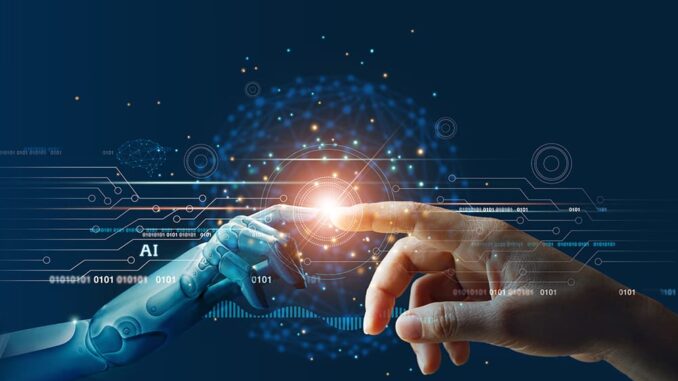
AI-generated content refers to various types of content—text, images, audio, video, and more—created using artificial intelligence technologies. With advancements in natural language processing (NLP), computer vision, and machine learning,
AI has become increasingly capable of producing high-quality content across multiple domains. Below is an overview of key aspects, technologies, applications, advantages, challenges, and ethical considerations surrounding AI-generated content.









### Key Technologies Behind AI-Generated Content
1. **Natural Language Processing (NLP):**
– **Language Models**: Advanced models like DeepAI’s GPT (Generative Pre-trained Transformer) series and Google’s BERT are capable of generating human-like text for various applications, such as chatbots, content creation, summarization, and translation.
– **Text Generation**: AIs can create articles, stories, poetry, and other written materials based on prompts or specified criteria.
2. **Generative Adversarial Networks (GANs):**
– Used primarily for generating images, GANs consist of two competing neural networks: a generator that creates new images and a discriminator that evaluates them. Variants like StyleGAN can produce highly realistic images.
3. **Diffusion Models:**
– These models create images by gradually refining noise into coherent images. Text-to-image systems like DALL-E and Stable Diffusion leverage this technology for generating images from textual descriptions.
4. **Text-to-Speech (TTS) Systems:**
– AI can convert written text into spoken words, generating lifelike audio outputs for applications such as virtual assistants, audiobooks, and voiceovers.
5. **Video Generation and Synthesis:**
– AI technologies are being developed that can generate video content, either from textual descriptions or as variations of existing video frames.
6. **Deepfake Technology:**
– Using generative models, deepfake technology can swap faces or create realistic videos where people appear to say or do things they never actually did, raising ethical concerns.
### Applications of AI-Generated Content
1. **Content Creation:**
– **Blogs and Articles**: Automated writing tools can help generate articles, blog posts, and reports, assisting writers and marketers.
– **Creative Writing**: AI can assist authors by providing creative prompts, story ideas, or even complete short stories.
2. **Marketing and Advertising:**
– Automated content generation can be used to create ad copy, social media posts, and product descriptions tailored to specific audiences.
3. **Art and Design:**
– AI-generated visuals, landscapes, and character designs can be employed in video games, animations, and digital art.
4. **Education:**
– AI can assist in generating personalized learning materials, quizzes, and educational content based on learner profiles and needs.
5. **Entertainment:**
– AI is used in the creation of music, scripts, and even fully animated shows, enhancing creativity and production efficiency.
6. **Social Media:**
– AI can generate posts and responses, engage users, and automate customer service interactions through chatbots.
7. **Real-Time Translation**:
– Automated systems provide translations and transcriptions for content in different languages, enhancing global communication.
### Advantages of AI-Generated Content
– **Efficiency**: AI can produce large volumes of content quickly, saving time for businesses and creators.
– **Cost-Effectiveness**: Automating content generation can reduce labor costs, especially for repetitive tasks.
– **Personalization**: AI can tailor content to individual preferences and needs, improving user engagement and satisfaction.
– **Creativity Enhancement**: AI can provide creative inspiration and novel ideas that humans may not have considered.
### Challenges and Ethical Considerations
1. **Quality Control**:
– While AI-generated content can be impressive, it is not always coherent or contextually accurate. Ensuring high standards of quality can be a challenge.
2. **Bias and Misrepresentation**:
– AI models can reflect biases present in their training data, leading to biased or discriminatory outputs.
3. **Misuse and Disinformation**:
– AI-generated content can be misused to create deepfakes, fake news, or misleading information, posing risks to society and democratic processes.
4. **Intellectual Property**:
– Ownership and attribution of AI-generated content can raise complex legal questions. Who owns the rights to content created by an AI?
5. **Job Displacement**:
– The automation of content creation can result in job losses in fields like writing, graphic design, and video production.
6. **Impact on Creativity**:
– There are concerns about the impact of AI on human creativity. Will reliance on AI for content generation reduce the necessity for human input?
### Conclusion
AI-generated content has opened new avenues for creativity, efficiency, and personalization across various fields. As the technology continues to evolve, it holds enormous potential for transforming industries such as entertainment, marketing, education, and beyond. However, alongside its benefits come significant challenges and ethical implications that must be addressed to ensure responsible use and maintain societal trust.
If you have specific aspects of AI-generated content you’d like to delve into further or particular technologies or applications you’re interested in, feel free to ask!


Leave a Reply